Fishing Mongolia
by Dr Matt Draisma
Hunter 9
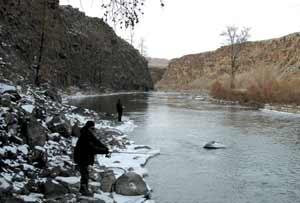
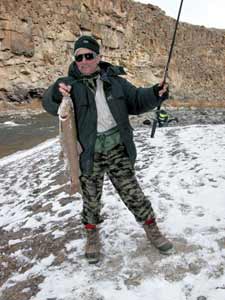
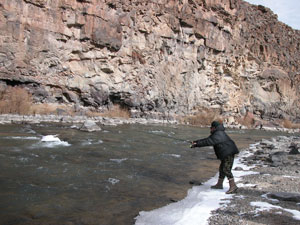
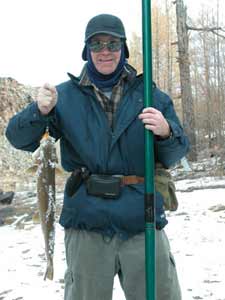
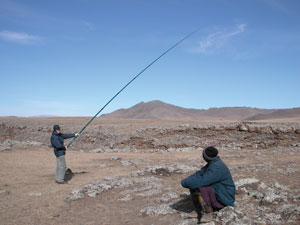
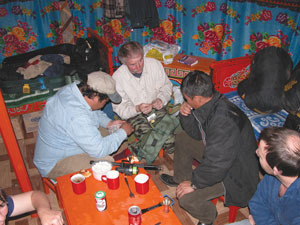
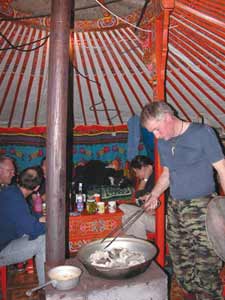 It was as if we were put into a time machine and were seeing through the eyes of Marco Polo, 800 years before our time. Around us, as we
travelled the rough tracks, Mongol nomadic herders were on the move
with their livestock, their household goods tied down on handmade
wooden yak wagons. Happy, smiling, sun-browned tribesmen and women,
traditionally dressed in blue, long-sleeved, silk-covered,
lambskin-lined long robes with bright orange or green silk sashes.
Flocks of fat-tailed sheep and cashmere goats grazed the yellowed
steppe as they ambled along. Herds of horses and yaks moved by in
clouds of dust, despite the snow on the hills and steppe. Smiling
children waved to us from half-disassembled gers, the native felt
tents, the surrounds littered with packages and bundles. It was autumn
in western Mongolia and it was the time to move down to the livestock wintering areas.
It was as if we were put into a time machine and were seeing through the eyes of Marco Polo, 800 years before our time. Around us, as we
travelled the rough tracks, Mongol nomadic herders were on the move
with their livestock, their household goods tied down on handmade
wooden yak wagons. Happy, smiling, sun-browned tribesmen and women,
traditionally dressed in blue, long-sleeved, silk-covered,
lambskin-lined long robes with bright orange or green silk sashes.
Flocks of fat-tailed sheep and cashmere goats grazed the yellowed
steppe as they ambled along. Herds of horses and yaks moved by in
clouds of dust, despite the snow on the hills and steppe. Smiling
children waved to us from half-disassembled gers, the native felt
tents, the surrounds littered with packages and bundles. It was autumn
in western Mongolia and it was the time to move down to the livestock wintering areas.
Our drivers finally turned off the rutted dirt track, which was the ‘road’ that would eventually take us to Tariat, a small town in the aimag (province) of Arkhangai. We bumped along, swerving between the sharp black volcanic rocks scattered on the flat, treeless ground leading to the river. The two grey-painted Russian 4WD Comby vans, until now, had handled the rough going with aplomb but I was suddenly fearful of multiple badly cut tyres as they picked their way through the hazardous terrain.
Paul and I had planned this treat to the Chaqluut River two and a half years ago around a camp-fire, during a fishing trip to Eden, NSW. Here we were, about to fish a river in Mongolia, where the fishing was legendary.
There were small patches of snow lying about and a cutting wind was blowing into our faces as we disembarked and walked to the edge of the steep gorge to check out the water. There, 50 feet below, was a majestic and pristine rolling river about 20-feet wide, its edges and banks lined with ice and snow, the waters swirling strongly around the large boulders. It looked and felt as cold as the infrared thermometer confirmed - a mere minus ten C! One of our native drivers, Jaaghaa, a fishing expert with limited English, pointed out a pool at the end of a small rapid below and emphatically said “fish”. I looked carefully through my polaroids, but was unable to confirm his diagnosis, although it had all the hallmarks of a good trout hole.
It appeared there was access to the sheer river gorge via a small side gully in the rocks, so we hurried back to the car and assembled our fishing gear. Our gear was brought all the way from Oz in anticipation for such an opportunity. I had elected to bring two excellent short telescopic Jarvis Walker spinning rods coupled with medium Daiwa A1600 reels full of nine-kilogram line, while Paul had chosen a huge 24-foot telescopic fixed-line fishing pole. He planned to trade it in later with one of the herders, who would convert it to a high-tech lasso pole. It would be far superior to the traditional wooden version in these parts.
Having donned extra coats, warm hats and gloves and girded our loins with fishing bags, with Jaaghaa in the lead, we headed down the steep and winding goat track into the river gorge. It was slippery going with the snow and ice on the rocks. Lower down we threaded our way through a patch of leafless, stunted birch and alders. Via a rocky scree beach we arrived at the rapid we had inspected from above. We were amazingly sheltered from the wind down so low, but in the shade the cold intensified. This didn’t help my fingers when tying on one of my gold wonder wobblers, a good old Aussie standby, also Jaaghaa’s personal choice of lures. In the process I showed Jaaghaa the patent-improved blood knot I always use, which surprisingly, was new to him.
Paul selected one of my homemade, weighted, buck-tail streamer flies in yellow - topped with red and dark brown - on a number six hook. My first choice was a number one (large) red and gold culta-weighted lure with an extra-large split shot about two foot up the line.
I proceeded to cover the head, middle and lower parts of the rapid without success, followed by a change to a gold spoon with similar results. Jaaghaa and Paul, thankfully, were not doing any better and I was beginning to suspect the place might be a bit of a dud. The water looked so good though, there just had to be fish in there. The lures we were using were all surface-action ones. Searching through the tackle box, I produced a deeper-travelling, medium-brown, orange-barred and bibbed Stump Jumper (they look like yabbies), which are popular on the Murray River for cod.
My first cast at the foot of the rapid produced a veritable brownish-grey ‘shark’, which followed it right to the icy edge of the stream before lazily melting back into the depths. A second cast was made to convince that fish to strike. The result was the same, except this time it was a slightly smaller fish closely following the lure. Again, without striking. What to do? It was obvious these fish were lying deep and would not be brought up by surface lures. A deep-running lure was indeed the answer in part. Then a thought sprang to mind. A cardinal rule for fly fishing: if the fish are showing an interest in a fly but not taking, go to a smaller size in the same pattern.
A feverish look in the tackle box revealed only one contender, a small-bibbed, black-backed silver herring about four centimetres long, not including the clear plastic bib. Smaller, with the same action but a different colour. This was the lure that had been the killer of several barramundi and countless queen fish during a past foray to the Gulf of Carpentaria. Would it do the job here? Time would soon tell.
I clipped it on to the line and cast out across the base of the rapids. The lure immediately went deep and vibrated tantalisingly, as the current arced it across to where the fish lay. Suddenly, the rod was jerked into a bow and I yelled a triumphant “Yes!” as I felt the weight of the fish, and wondered what it was, how big and what it would do next.
It seems the water was near freezing and this affects the fish’s energy metabolism. It behaved just like a large lake brown, throwing its head and body about with wallowing side movements, just dangerous enough to risk shaking the hooks if landed prematurely but not enough fight to really keep me on my toes. So I kept the rod elevated, confident that the drag was correctly set and waited him out. After several minutes the fish allowed itself to be gently shepherded to the icy edge. The edge was where the real risk started. This ice-edge, due to the rippling motion of the water, was several inches above water level and the fish had to be lifted up and over it. After three heart-stopping attempts, it slid over and skidded onto the snow-covered gravel beach and was mine. Our first Mongolian fish, a taimen, so we were told. The fish was very long-bodied and salmonid-like, a deep brownish-grey and more than three kilograms. Jaaghaa told us it was a small one and later showed us a picture of a four-foot 25 kilogram ‘normal’ one.
Paul and Jaaghaa redoubled their efforts with new zeal, while Gordon, our photographer, recorded the catch for posterity in the poor light of the gorge. My reputation was safely confirmed.
Having dispatched my fish with a sharp blow to the top of the head with a handy lump of driftwood, Paul slit open the belly and stomach to see what the fish had been feeding on. It was full of brown-cased caddis larvae and the odd green mayfly nymphs! No wonder they were staying deep.
I recommenced casting in a higher position on the rapid, having called Paul over to try his luck with the buck-tail fly in the lower part, where I had caught my fish. Unfortunately, prior fishing advice from Mongolia was for spoons and minnow-streamer flies but did not include caddis larvae, so we didn’t bring any with us. However, it was not long before Paul hooked a smaller but good-sized fish, which the huge pole rod handled with majestic ease. Soon a smiling Paul was holding up his first Mongolian catch. Jaaghaa had given up; having these foreigners with their secret weapons upstage him was too much to bear.
I moved down to the lower end of the rapid where the fish seemed to be concentrated and made several more casts with the bibbed herring. Soon another fish was bounding about on the end of my rod. Once landed, this magnificent fish, only slightly smaller than the first, revealed he was truly hooked on my lure. All three arms of the rear hook were in both jaws, locking them closed.
Later, Paul’s rod and my fly caught another similar taimen to Paul’s first, this time in the hands of a delighted Tony, another party member. During our fishing foray we had been receiving shouts of encouragement from a gallery of spectators at the lip of the gorge. The spectators included Enktuvshen - our female interpreter, Nicole, - our fifth travelling companion, the now retired Jaaghaa, our young driver and two locals who were hitching a lift to the next village. They were perched grandstand-like, watching the proceedings.
The sun was starting to drop as we called it a day and made our way back out of the gorge. Tony stayed back and skinny dipped in the icy river, much to the amusement of the aforementioned gallery. We slowly continued on our way and arrived at the soum (village) at dusk, finding ourselves in a spare ger as guests of the local governor, a veterinarian and colleague.
Paul and I discussed the ramifications of the important animal-borne human diseases and the impact of Hydatid disease in the community - and its possible methods of control - this being the original purpose of our expedition to several such villages.
That evening I was elected cook, having caught the most fish. After a careful boneless filleting job, I steamed the large fish pieces on the basic but functional wood stove in our ger. I cooked a delicious yak butter and strong garlic sauce to accompany the fish and the mound of spuds and cabbage I had cooked up. A luxury in terms of local fare, where rice and boiled mutton is the main staple. Even the drivers and our interpreter were impressed. We washed it all down with Arak, the local beer, which is made from fermented mare’s milk. Nicole, poor girl, is allergic to seafood and had to endure the cold mutton from the day before. She told me later that all was forgiven, so I remembered to send her a can of sardines for Christmas. After all, it’s the thought that counts.
